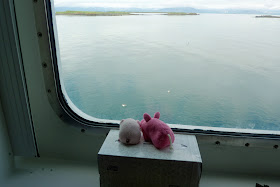On the morning of July 20th, after a welcome night of sleep, we entered the Breidafjord, a large shallow bay which separates the Westfjords from the rest of Iceland. On the port side of the Explorer was the Latrabjarg, Europe's largest bird cliff at 14 km long and 441 meters high. If you don't count Greenland or the Azores it is also the westernmost point of Europe. Capped with a layer of fog or cloud, it looked most mysterious.
Joan and I were two of four guests on the bridge when a large creature came close by the starboard side. Consulting with the captain, he identified it as a basking shark, the second largest fish after the whale shark. Many of my at-sea photos were taken from the bridge, which provides an elevated viewpoint and knowledgeable and experienced spotters, including the captain. In addition, you are sheltered from the weather on the bridge. The only downside is that I'm taking photos through windows.
A bit later everyone on board had a good look a small pod of orcas, or killer whales, that we encountered further into the bay. They hung around for at least half an hour.
The youngster always stayed close to its mother.
Here is a closer look at the accompanying male, with the large dorsal fin.
The pigs accompanying us on this voyage, Katy and Posy, usually watched from the cabin window, although they sometimes attended lectures if there was the possibility of interesting pictures.
The pigs accompanying us on this voyage, Katy and Posy, usually watched from the cabin window, although they sometimes attended lectures if there was the possibility of interesting pictures.
During lunchtime, guests can take their meal in the observation lounge, where the views are better, instead of the dining room. On a pretty day such as today it fills up rapidly.
Flatey island, our goal, is indeed flatter than most of Iceland, as this view from our approach shows.The Explorer was too large to use the ferry dock, so we reached the shore via zodiac.
Flatey was a commercial and cultural hub for a long time. For example, a monastery was founded in 1172. The island had a large population for its small geographic size from the mid-18th Century through the 19th Century, but in the 20th Century it dwindled, until now the year-round population is only five. However, there are a large number of summer homes and guest houses on Flatey, so its population swells during the summer.
Flatey is visited year-round by a ferry. From the settlement of Iceland to this day it is easier to travel by boat from any point on the Breidafjord to another than to use the roads.
This photo shows how the village center appears from the spot of our zodiac landing.
The first leg of our walkabout was to the ferry dock, which has a small café and gift shop. Outside fish were drying.
Sheep have been the major livestock of Iceland for a thousand years.
They are very relaxed and comfortable.
Next we visited the church, built in 1926.
The interior of the church was painted with scenes of island life and history in the 1960s by a Spanish painter, Baltasar Samper.
Here is a closeup of one section.
Close by is the library, the oldest and smallest in Iceland, established in 1864.
Inside, among other books, is a copy of the Flateyjarbók, or Flatey Book, written in the late 14th Century. The original book remained on Flatey until the mid 17th Century, and was repatriated to Iceland from Denmark in 1971.
Then it was time for us to walk through the village on our way to the bird sanctuary. On our way we stopped to admire the knickknacks and trinkets that some of the youngsters had created and displayed for sale. When we reached the bluffs,
it was PUFFIN TIME. There was a flotilla of Atlantic puffins just off the shore (click on the photo to enlarge).
A few souls clambered down for a better, more contemplative look.
Too soon it was time to wander back to the zodiac landing for a zodiac cruise. On our way we watched a couple of families come out to play in the small harbor in what must have been very cold water. But then, these are hardy Icelanders!
One of the zodiacs on its cruise ...
Our cruise consisted of circumnavigating the small bird island just off the harbor. There were closeups of puffins outside their burrows,
hanging out on rocks,
and swimming in the water,
as well as nesting kittiwakes.
Then it was time to return to the Explorer and the captain's Welcome Cocktail Party. This began 36 hours at sea, crossing the Denmark Strait to Greenland.
July 21st, the transit day, was filled with lectures and time to hang out on the bridge. Lectures included The Geologic History and Tectonic Setting of Greenland and Iceland, Introduction to the Vikings, An Introduction to Greenland and Arctic Landings, and not least Guest Speaker Tim Severin and the first part of his description of the Brendan Voyage. Also our boots, poles, and jackets were, as necessary, decontaminated to avoid bringing non-native species of plants, insects, and the like to Greenland.
The next morning would find us off the east coast of Greenland and Skjoldungen Island.




























What a very informative piece about Flatey and the ferry trip. I'm jealous you got to see Orcas. Such magnificent creatures. There are other ferries too in Iceland that takes you to very desolate plases like Látravík and Drangey. Here is a list of all ferries in Iceland. Where to board them and where they go.
ReplyDeletehttp://www.rent.is/blog/ferries-in-iceland/
Safe travels